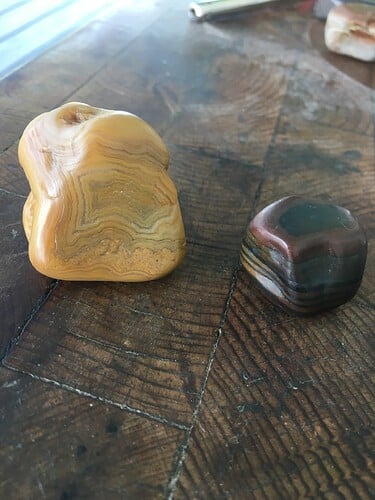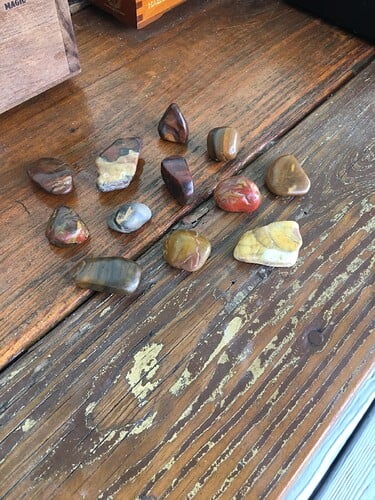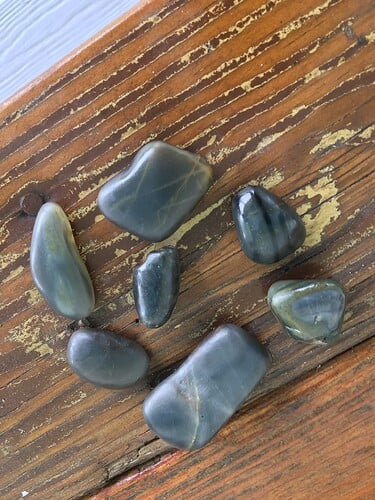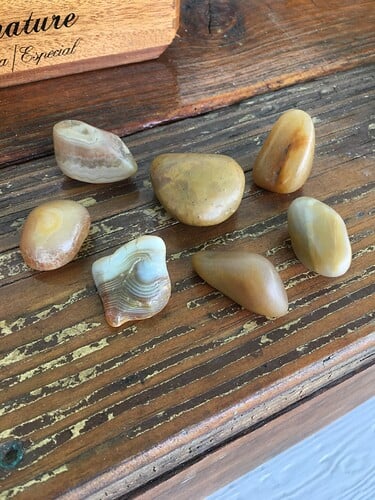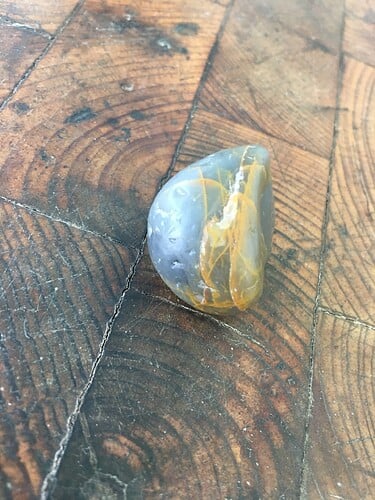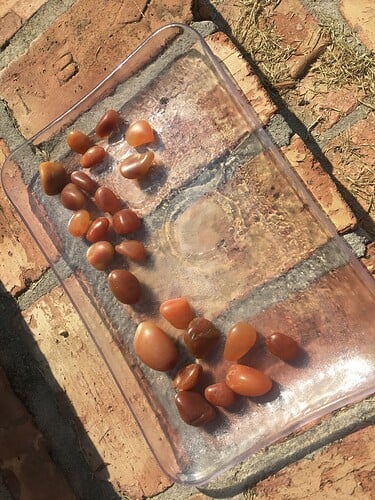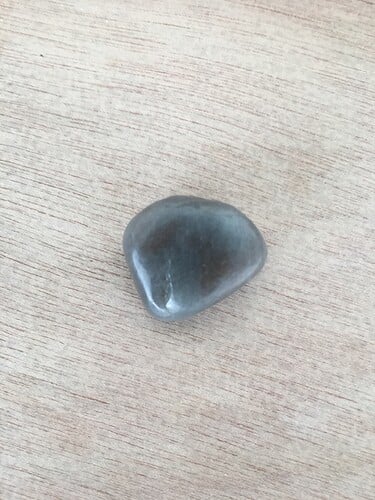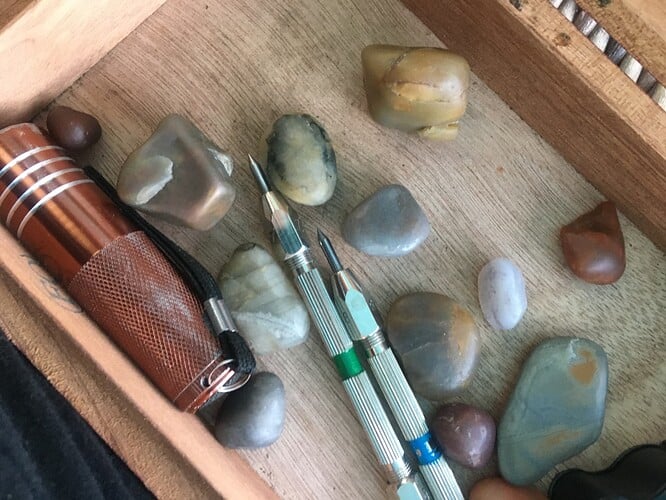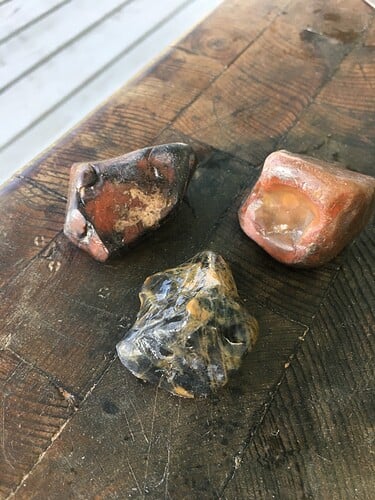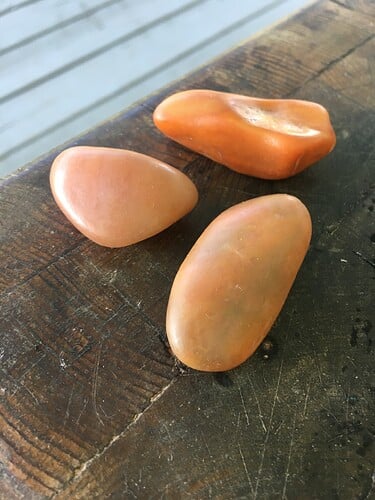I found the banded stone in a bucket of stones I was throwing into the garden. I saw the shape, though the stone was a greyish blue color. When I picked it up I saw the flat sides and felt how heavy it is.
The yellow agate was going into the garden also, when I noticed it’s color.
Thought you may enjoy the photo.
2 Likes
That is an interesting pattern in your flooring or table top as well. ;))
1 Like
It’s a really old and massive chopping block. 
Here’s some more photos of my favorites.
1 Like
This one is a bit of a head scratcher. RI is 1.54-1.55, but the hardness is between 8 and 9; no scratch at 8 and 9 scratches slightly.
It’s transluscent. I’m not sure what the golden yellow stuff is.
I am wondering if some of these may be andesine. They are lighter than quartz.
The yellow agate reminds me of a Fairburn type agate. I assume that it is a natural waterworn piece and has not been tumbled by modern methods. If so it appears to have traveled a considerable distance by way of natural forces. Documentation shows that Fairburn’s have been found across large areas in the Midwest, possibly to your area as well.
Fairburn agates are named after the town of Fairburn, about 30 miles to the south of Rapid City, SD… agates form in sandy limestones, with silica present, alkaline rocks like limestone facilitate the dissolution and reprecipitation of silica as agates… the Black Hills were uplifted as dome during the time of the formation of the Rockies…subsequent erosion reduced the Hills from an estimated 14,000 feet to the subdued hilly area at present… agates are scattered over a wide area east of the Black Hills, found in stream beds and scattered over dry land as the less attractive “prarie agates” and “bubble gum agates”… since the agates travelled far and wide, it is possible but not highly likely that they made their way, all the way down to Louisiana… but I could be wrong on that…
andesine is a plagioclase feldspar that is 30-50% calcium in solid solution with sodium… plagioclase feldspars weather relatively quickly and would not likely survive a long trip down the river…
None of my stones were tumbled and they were all already smooth and in the shapes they are in, with a very few exceptions. All I did was polish them with sanding discs and polish with wool pads. All of them were extraordinarily dirty and mostly grey looking.
One of the things that initially peaked my interest was the thought that only the best (hardest) would have survived a long water journey all the way to here.
But, I just don’t know. Louisiana was under water at one point in history.
The variety of color and type, along with their shapes and smoothness is what led me to think they may have been bought here by indigenous people trading or perhaps for some spiritual purpose.
The gravel pit they came from reminds me very much of an area called the Tepees in the Painted Desert, Petrified Forest National Park in Arizona. Of course, they are not the same, but it is all sand and looks like another world.
Thanks Kandace and Steven.
can you determine the specific gravity?.. the rock is pretty hard… still looks like a quartz stone of some kind… agates can come in blue but uncommonly, although the Apache Creek area of Southeastern New Mexico is full of blue banded agate, blue quartz and rare natural green quartz crystals. Andesine feldspar won’t survive the weathering and wear and tear of being transported hundreds or even thousands of miles down stream. I noticed that agate is the state rock of Lousiana… some of the gravel beds undoubtably hold agates from local sedimentary strata. Cretaceous and Mesozoic sedimentary beds in the northern part of the state host fossil, limestones are the local sources of agates… calcite, agate, pyrite, barite are listed as rockhounding minerals in the state. We have friends who live in Shreveport. They are hunting rocks all of the time. One of them is trying to start an online business in buying and selling rocks found in LA, AR, OK and east TX… the found and gave me several nice barite roses. So, it maybe that the agates and other gravel bed rocks did not have to come from a thousand miles away but originated within LA itself…Good luck and happy hunting… finding gem quality agates is hard, but once in a while, you will find a real beauty among the more common agates… Good luck and happy rock hunting… the best gems and specimens are the ones, not bought but found yourself…
Okay. This one is a gorgeous fairy tale blue with a ethereal violet tone. It’s completely transparent and is a yellow color when you shine the flashlight through.
It sort of scratches with a 9 hardness stick in some directions but in others, you can’t scratch it.
It is 52 carats and just has the most beautiful sheen. The refractive index is 1.78 or 1.79.
Is it a spinel, gahnospinel or a sapphire? I don’t know.
I found it in a full drawer of stones I hadn’t gone through. It looked just like a blue/grey opaque rock. The shape is what caught my eye and as I began to polish it, my eyes popped out of my head.
the refractive index is pretty high… sapphire has a similar refractive index of 1.76 to 1.77.
the crystal is also anisotropic and will have a hardness that varies slightly on the orientation of the crystal…spinel has a refractive index of 1.71 to 1.72, hardness is 7.5 to 8… test it for specific gravity… corundum stones are dense with a SG of about 4. Spinel runs 3.58 to 3.61…The more properties you can identify the narrower the range of possibilities as to what it is. If properties tell you that it could be a rare or valuable stone, then taking it in for expert testing and analysis by a certified gemologist in person will be more informative than posting a picture, even with the give physical and opticla properties. Knowing where it originated from is also highly important… if found in a gravel bed in MS, not too helpful.
Gravel bed in Louisiana, not Mississippi. 
Will do; specific gravity as soon as I can. It’s kind of a busy week.
I’m so proud of myself for mastering the RI thing.
I just love these stones. They are amazing.
One more thing and it’s why I started this thread. These are all from the same geographic area and I feel as a group they tell a story. We don’t have “in situ” here. We have “water moved it”.
gravel beds makes your job harder… keep on trying and best of luck…
You can see the lovely color a bit better here. Some of the other stones don’t scratch at 9 either.
Thanks for your interest Steven.
most likely blue chalcedony which is quite common… only problem is that chalcedony is quartz and should easily scratch with 9…if you have something that hard, you should test specific gravity… corundum stones are dense, heavy with SG of about 4… heavier than most stones…anisotropic scratching is common… Kyanite is 5 along one axis and 7 along another…that is the usual example of anisotropy with scratching…if it won’t scratch wih 9, even if a firm scratch, it should scratch with a carborundum grinding wheel or knife sharpener… hardness is 9.5…
The specific gravity is 4. I tested it four times. 4.0.
I can’t believe it.
Maybe I shouldn’t have been shaving flat polished spots into the stone with a diamond disc.
1 Like
if it measures out to sapphire, it could very well be… sapphire is also anisotropic to stratch as it’s hexagonal… If you think it really is sapphire, you will need to have it examine and tested by an expert. there’s no substitute for an expert certified gemologist to do a definitive ID for you. I think that you have taken it as far as you can on this website with pictures and physical/optical properties that you have measured, assuming that they were measured accurately with reproducible results… It it is indeed sapphire, you may not have a cuttable,gem quality stone, yet finding it yourself makes it invaluable… hope it turns out what you think it is… best wishes and the best of luck in getting a definitive ID…finding the resources and persons able to do this should not be too difficult as New Orleans is a big city. You might be able to find someone locally thru a brick and mortar fine jewerlry store also… please post the results once you find out…
If anyone else looking at this thread has another idea, please state so… Thanks to you and everyone participating. and once again best of wishes and best of luck.
a flat polished spot will give you a better RI than a curved surface.
I will post results. I am working on it.
